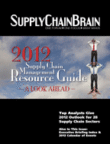
Visit Our Sponsors |
|
|
|
|
|
|
|
|
|
|
|
|
|
|
|
|
|
|
|
|
|
|
|
|
|
|
|
|
|
|
|
|
|
|
|
|
|
|

Logistics companies rely heavily on infrastructure for storage, manipulation and transportation, which has important implications for the direct costs of infrastructure assets and their maintenance. It also directly impacts the costs caused by interruptions to operations in the event of asset breakdown or failure.
PLM tools (as opposed to full-blown PLM systems) can help these companies solve two issues:
1. With many assets from many manufacturers, asset documentation is not necessarily compatible, and will almost certainly be challenging to manage (particularly in the case of different formats, naming conventions, etc.) - not to mention that 3D drawings can only be used with PLM tools.
2. PLM tools go beyond providing access to information; they also help users track asset performance (in combination with EAM), search for maintenance instructions and spare part equivalencies, and assess the impact of replacing one component with another.
In fact, logistics companies can leverage a combination of EAM and PLM functionality at each stage of the asset lifecycle:
• Improper installation can lead to service interruptions and workplace hazards, resulting in financial losses as well as loss of human life. This risk can be reduced by using the technical specifications created by PLM tools, which can also provide instructions and best practices for installation. For complex installations, each step of the process should be tracked in the EAM solution to ensure that no important detail is left uncovered.
• During its operation, an asset needs to comply with local and international regulations, which are embedded in the design of the asset by PLM and tracked in EAM. Asset performance monitoring can be executed based on parameters defined during asset design and linked to alert/notification workflows managed in EAM.
• The cost of maintenance can end up being higher than the initial cost of the asset, particularly in the event of improper installation or operation. But operational disruption can be mitigated if technicians can use PLM tools to search for the technical specifications of the asset and its components, and EAM functionality to manage the resources (human, spare parts, tools, etc.).
• The end of the lifecycle and the disposal of an asset generate costs related to replacement (or to refurbishment or re-use in other operations). PLM tools can provide useful information about extending the life of an asset and the alternative uses it can be put to. At the same time, EAM systems manage asset depreciation and provide historical data on the real obsolescence of the asset under conditions of proper use and maintenance.
The Outlook
"If it ain't broke don't fix it" is probably the worst strategy a logistics company can adopt when it comes to managing its assets. Interruptions and accidents should be actively prevented, on the premise that assets used at maximum capacity provide the highest possible returns on investment. PLM and EAM software can help logistics companies limit the downtime of their assets, thus reducing the costs generated by interruption to business operations.
Keywords: Product Lifecycle Management, Technology; Third-Party Logistics, Logistics, Technology Evaluation Centers, PLM Tools, PLM Systems, Maintenance
RELATED CONTENT
RELATED VIDEOS
Timely, incisive articles delivered directly to your inbox.






